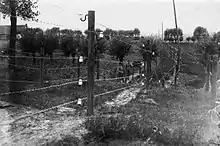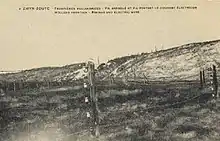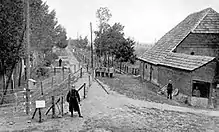Wire of Death
The Wire of Death (Dutch: Dodendraad, German: Todesdraht) was a lethal electric fence created by the German military to control the Dutch–Belgian frontier after the occupation of Belgium during the First World War.

Terminology
The name 'Wire of Death' is an English rendition of one of its popular Dutch names; Dodendraad which literally means "Wire of the dead". As the war continued and more and more victims fell to the electric fence it became known as simply De Draad meaning "The Wire". To the German authorities it was officially known as the Grenzhochspannungshindernis ("High Voltage Frontier Barrier"). Parallels have been made between the 'Death Wire' and the later Iron Curtain.[1]
Construction


As Germany invaded neutral Belgium, Belgians began to cross the border to the Netherlands en masse. In 1914 one million Belgian refugees were already in the Netherlands, but throughout the war, refugees kept coming and tried to cross the border. Many wanted to escape German occupation, others wanted to join their relatives who had already fled, and some wanted to take part in the war and chose this detour to join the forces on the allied front.
Construction began in the spring of 1915 and consisted of over 200 km (125 mi) of 2,000-volt wire with a height ranging from 1.5 to about 3 m (5 to about 10 ft) spanning the length of the Dutch-Belgian border from Aix-la-Chapelle to the River Scheldt. Within 100–500 m (110–550 yd) of the wire, anyone who was not able to officially explain their presence was summarily executed.
Result and legacy
The number of victims is estimated to range between 2,000 and 3,000 people. Local newspapers in the Southern Netherlands carried almost daily reports about people who were 'lightninged to death'. However, many also succeeded in overcoming the fence, often by employing dangerous or creative methods, ranging from the use of very large ladders and tunnels to pole vaulting and binding porcelain plates onto shoes in an attempt to insulate themselves.[2]
The wire also separated families and friends as the Dutch–Belgian border where Dutch and Flemings (Dutch-speaking Belgians), despite living in different states, often intermarried or otherwise socialized with each other. Funeral processions used to walk to the fence and halt there, to give relatives and friends on the other side the opportunity to pray and say farewell.[3] The (neutral) Dutch government, which initially didn't object, protested the wire later on several occasions after its existence caused public outrage in the Netherlands. The great number of fatalities not only resulted in a sharp increase in Dutch Anti-German sentiment (in a country which had up until then been mostly hostile to Britain due to the Second Boer War) but also made smuggling goods in the border area much more dangerous and therefore more lucrative for local criminals.[4]
The fence did not completely follow the border and did not cross rivers. The Germans also allowed locals to pass through for church services, on market days and during harvest.[5] In October 1918 the Germans opened the border to allow refugees from France and Belgium through rather than clog up German lines of communication in Belgium. At the end of the war, the Kaiser crossed the border from Belgium into the neutral Netherlands to take refuge there.
Immediately after the signing of the armistice in November 1918, the power plants around the wire were shut down and locals on both sides of the border soon destroyed the much-hated fence. Today all that remains of the original wire are some warning signs; however in some areas certain stretches have been reconstructed such as near Hamont-Achel, Zondereigen, Molenbeersel and between Achtmaal and Nieuwmoer in nature reserve "De Maatjes" by observation post "De Klot".
References
- "De Dodendraad" [The Death Wire] (in Dutch). Retrieved 18 March 2013.
- Fact sheet 'Bunkergordel' on the wire
- De Draad, including English summary
- Van Waesberghe 2001.
- Abbenhuis 2006, p. 168.
Bibliography
- Janssen, Herman, ed. (2013). Hoogspanning aan de Belgisch-Nederlandse Grens: de Eerste Wereldoorlog aan de rijksgrens met Baarle. Baarle-Hertog: Heemkundekring Amalia van Solms. ISBN 978-90-74945-00-4.
- Abbenhuis, Maartje M. (2006). The Art of Staying Neutral: the Netherlands in the First World War, 1914-1918. Amsterdam: Amsterdam University Press. pp. 164–9. ISBN 9789053568187.CS1 maint: ref=harv (link)
- Abbenhuis, Maartje (2007). "Where war met peace. The borders of the neutral Netherlands with Belgium and Germany in the First World War, 1914 - 1918". Journal of Borderlands Studies. 22 (1).
- Van Waesberghe, Steven (2001). Smokkel in het Land van Waas tijdens de Eerste Wereldoorlog (Licentiaat thesis). Universiteit Gent. Retrieved 1 November 2015.